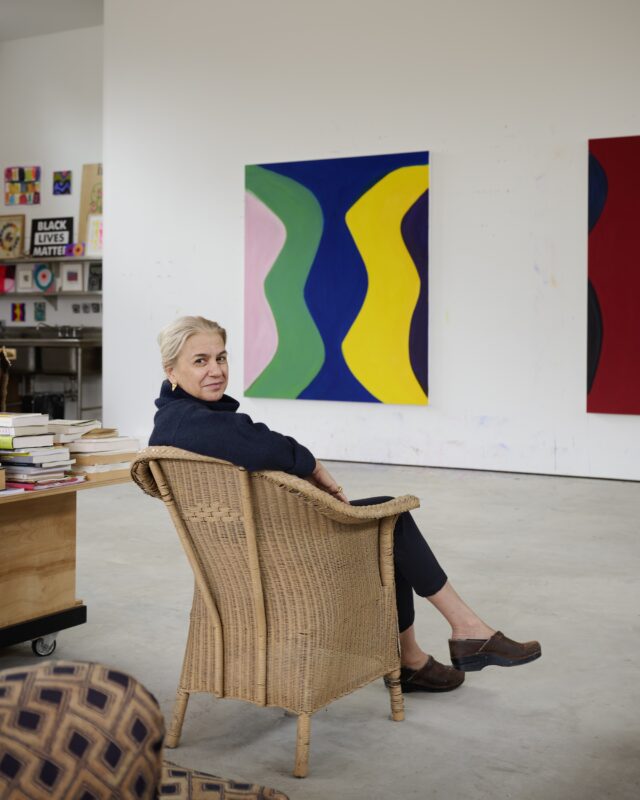Lisson Gallery has announced the representation of Oliver Lee Jackson, the painter, sculptor and printmaker whose creations open up spaces for contemplation and interpretation, as well as encounters with seen and unseen worlds.

I’m so pleased that Lisson Gallery has taken on my work to show in London and elsewhere. I’ve been impressedby Alex’s keen eye in looking at and selecting my works for the gallery. It has been a pleasure to meet him and theLisson Gallery staff, and I look forward to working together.
Oliver Lee Jackson
Jackson has long engaged in freeing form and matter from the strictures and false oppositions between figuration and abstraction, preferring hybridity, ambiguity and improvisation with his materials over fixed meanings and didacticism. The artist will present for the first time with Lisson Gallery at Art Basel, Basel (13th-16th June 2024), before his solo exhibition with the gallery in London, opening in November 2024. Lisson Gallery will represent Jackson in collaboration with Andrew Kreps Gallery, New York, and BLUM, Los Angeles. Beginning with gridded compositions in the 1960s and then moving his large canvases to the floor in the 1970s, in order to approach his work from multiple orientations, Jackson’s images remain based in reality and bound to human experience. “Every exchange we have, regardless of whether we call it spiritual or not,” says the artist, “isthrough the world, by the senses, absorbing things in things, exploiting things by things, always relationships with things.”

95 x 72 in © Oliver Lee Jackson
His chosen materials–stone, steel, wood, marble, fabric, paint–become the conduit for him to communicate emotions, moods and shared phenomena through the making of objects and images. The figure is a constant presence–sometimes overt, sometimes fragmentary and fugitive–in all of Jackson’s work, acting as both starting point and anchor for the marks, glimpses, moments and motives behind each composition. Even in two dimensions, the relative weights and volumes of brushstrokes, handprints and color expanses create fluctuating densities, depths and spatial possibilities. Demonstrative narratives or references to actual historic events are fleeting and non-linear, excepting important series such as his 1970s paintings inspired by photographs of Anti-Apartheid demonstrators fleeing the Sharpeville Massacre of 1960 in Johannesburg. Otherwise, Jackson cites influence from both African and European art traditions to feed his gestural representations that suggest atimeless, bodily flow of life force, memory and atmosphere.

I’ve seen Oliver’s work for some time, primarily at Andrew Kreps exhibitions and have admired the ambition of the practice. However, it was the first visit to the studio that was a true revelation, understanding his approach to form and art history is singular, his ability to meld style and subject to his own vernacular is amazing to see unfold. We are very excited to bring Oliver’s work to a new audience with his first exhibition in Europe this coming November.
Alex Logsdail, CEO Lisson Galley
Oliver Lee Jackson was born in 1935, St. Louis, Missouri and now lives and works in Oakland, California, USA. After attending the University of Iowa and advising the St. Louis collective of musicians, poets, dancers and artists known as the Black Artists Group (known as BAG) in the late 1960s, Jackson relocated to the West Coast to be a professor of art at the California State University, Sacramento, from 1971 until 2002, where he initially developed a curriculum for the Pan African Studies program. In addition to numerous collaborations with writers, musicians and dancers, Jackson has worked on large-scale commissions and held major solo presentations at the Saint Louis Art Museum, St. Louis, MO (2021); di Rosa Center for Contemporary Art, Napa, CA (2021); National Gallery of Art, Washington, DC(2019); Contemporary Art Museum, St. Louis, MO (2012); Harvard university, Cambridge MA (2002); Crocker Art Museum, Sacramento, CA (1993, 1984, 1977); Seattle ArtMuseum (1982) among others. His work is also shown by Rena Bransten Gallery, San Francisco, CA.
In 2023 he was presented with the Lee Krasner Award for lifetime achievement by the Pollock KrasnerFoundation, and he was the recipient of the Award in Painting and Sculpture, Awards in the Visual Arts, Flintridge Foundation, Pasadena, CA (2003/2004); the Fleishhacker Foundation Eureka Fellowship (1993); a grant from Art Matters, New York (1988); the Nettie Marie Jones Fellowship (1984); and a National Endowment for the Arts Fellowship (1980-81). His work is included in the permanent collections of the Art Institute of Chicago, IL; Detroit Institute of the Arts, Detroit, MI; Fine Arts Museums of San Francisco, CA; Los Angeles County Museum of Art, Los Angeles, CA; the Metropolitan Museum of Art, New York, NY; Museum of Contemporary Art, Chicago, IL; Museum of Contemporary Art, San Diego, CA; Museum of Modern Art, NewYork, NY; the National Gallery of Art, Washington, DC; New Orleans Museum of Art, New Orleans, LA; Portland Art Museum, Portland, OR; Saint Louis Art Museum, St. Louis, MO; San Francisco Museum of ModernArt, San Francisco, CA; San Jose Museum of Art, San Jose, CA; Seattle Art Museum, Seattle, WA and many more.







